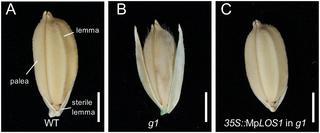当前位置:
X-MOL 学术
›
PLOS Biol.
›
论文详情
Our official English website, www.x-mol.net, welcomes your feedback! (Note: you will need to create a separate account there.)
A conserved regulatory mechanism mediates the convergent evolution of plant shoot lateral organs.
PLOS Biology ( IF 9.8 ) Pub Date : 2019-12-09 , DOI: 10.1371/journal.pbio.3000560 Satoshi Naramoto 1 , Victor Arnold Shivas Jones 2 , Nicola Trozzi 1, 3 , Mayuko Sato 4 , Kiminori Toyooka 4 , Masaki Shimamura 5 , Sakiko Ishida 6 , Kazuhiko Nishitani 7 , Kimitsune Ishizaki 8 , Ryuichi Nishihama 6 , Takayuki Kohchi 6 , Liam Dolan 2 , Junko Kyozuka 1
PLOS Biology ( IF 9.8 ) Pub Date : 2019-12-09 , DOI: 10.1371/journal.pbio.3000560 Satoshi Naramoto 1 , Victor Arnold Shivas Jones 2 , Nicola Trozzi 1, 3 , Mayuko Sato 4 , Kiminori Toyooka 4 , Masaki Shimamura 5 , Sakiko Ishida 6 , Kazuhiko Nishitani 7 , Kimitsune Ishizaki 8 , Ryuichi Nishihama 6 , Takayuki Kohchi 6 , Liam Dolan 2 , Junko Kyozuka 1
Affiliation

|
Land plant shoot structures evolved a diversity of lateral organs as morphological adaptations to the terrestrial environment, with lateral organs arising independently in different lineages. Vascular plants and bryophytes (basally diverging land plants) develop lateral organs from meristems of sporophytes and gametophytes, respectively. Understanding the mechanisms of lateral organ development among divergent plant lineages is crucial for understanding the evolutionary process of morphological diversification of land plants. However, our current knowledge of lateral organ differentiation mechanisms comes almost entirely from studies of seed plants, and thus, it remains unclear how these lateral structures evolved and whether common regulatory mechanisms control the development of analogous lateral organs. Here, we performed a mutant screen in the liverwort Marchantia polymorpha, a bryophyte, which produces gametophyte axes with nonphotosynthetic scalelike lateral organs. We found that an Arabidopsis LIGHT-DEPENDENT SHORT HYPOCOTYLS 1 and Oryza G1 (ALOG) family protein, named M. polymorpha LATERAL ORGAN SUPRESSOR 1 (MpLOS1), regulates meristem maintenance and lateral organ development in Marchantia. A mutation in MpLOS1, preferentially expressed in lateral organs, induces lateral organs with misspecified identity and increased cell number and, furthermore, causes defects in apical meristem maintenance. Remarkably, MpLOS1 expression rescued the elongated spikelet phenotype of a MpLOS1 homolog in rice. This suggests that ALOG genes regulate the development of lateral organs in both gametophyte and sporophyte shoots by repressing cell divisions. We propose that the recruitment of ALOG-mediated growth repression was in part responsible for the convergent evolution of independently evolved lateral organs among highly divergent plant lineages, contributing to the morphological diversification of land plants.
中文翻译:

保守的调控机制介导了植物新芽的侧向器官的趋同进化。
陆地植物枝条结构进化出多种多样的侧器官,以适应陆地环境的形态,其中侧器官独立地出现在不同的谱系中。脉管植物和苔藓植物(基本分叉的陆地植物)分别从孢子体和配子体的分生组织发育出侧器官。了解不同植物谱系中侧向器官发育的机制对于了解陆地植物形态多样化的进化过程至关重要。但是,我们目前对侧向器官分化机制的了解几乎完全来自种子植物的研究,因此,目前尚不清楚这些侧向结构如何进化以及常见的调控机制是否控制类似侧向器官的发育。这里,我们在苔藓类植物苔藓(一种苔藓植物)中进行了突变筛选,该苔藓植物产生配子体轴和非光合鳞片状的侧器官。我们发现,拟南芥的轻度依赖短螺旋体1和Oryza G1(ALOG)家族蛋白,名为M. polymorpha LATERAL ORGAN SUPRESSOR 1(MpLOS1),调节马尔凯顿州的分生组织维持和侧向器官发育。MpLOS1的突变优先在侧器官中表达,诱导具有错误指定身份的侧器官和增加的细胞数,此外,还导致根尖分生组织维持缺陷。值得注意的是,MpLOS1表达挽救了水稻中MpLOS1同系物的细长小穗表型。这表明ALOG基因通过抑制细胞分裂来调节配子体和子孢子芽中侧器官的发育。
更新日期:2019-12-11
中文翻译:

保守的调控机制介导了植物新芽的侧向器官的趋同进化。
陆地植物枝条结构进化出多种多样的侧器官,以适应陆地环境的形态,其中侧器官独立地出现在不同的谱系中。脉管植物和苔藓植物(基本分叉的陆地植物)分别从孢子体和配子体的分生组织发育出侧器官。了解不同植物谱系中侧向器官发育的机制对于了解陆地植物形态多样化的进化过程至关重要。但是,我们目前对侧向器官分化机制的了解几乎完全来自种子植物的研究,因此,目前尚不清楚这些侧向结构如何进化以及常见的调控机制是否控制类似侧向器官的发育。这里,我们在苔藓类植物苔藓(一种苔藓植物)中进行了突变筛选,该苔藓植物产生配子体轴和非光合鳞片状的侧器官。我们发现,拟南芥的轻度依赖短螺旋体1和Oryza G1(ALOG)家族蛋白,名为M. polymorpha LATERAL ORGAN SUPRESSOR 1(MpLOS1),调节马尔凯顿州的分生组织维持和侧向器官发育。MpLOS1的突变优先在侧器官中表达,诱导具有错误指定身份的侧器官和增加的细胞数,此外,还导致根尖分生组织维持缺陷。值得注意的是,MpLOS1表达挽救了水稻中MpLOS1同系物的细长小穗表型。这表明ALOG基因通过抑制细胞分裂来调节配子体和子孢子芽中侧器官的发育。


























 京公网安备 11010802027423号
京公网安备 11010802027423号